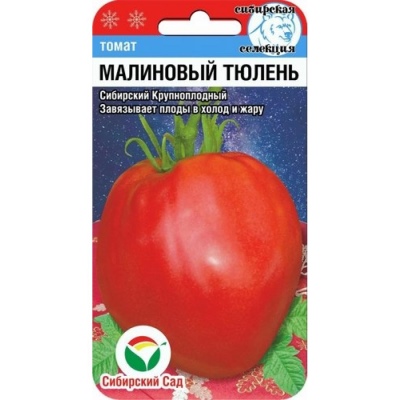
- Authors: AF "Siberian Garden"
- Category: grade
- Growth type: indeterminate
- Appointment: fresh consumption, for ketchup and tomato paste
- Ripening period: mid-early
- Ripening time, days: 110
- Growing conditions: for open ground, for closed ground
- Bush height, cm: up to 180
- Ripe fruit color: pink
- Fruit shape: elongated cordate
Not all tomatoes can boast of some particularly record productivity. This fully applies to the Crimson seal. But on the other hand, this variety has its own, no less attractive features that definitely deserve study.
Description of the variety
The raspberry seal was developed by the Siberian Garden agricultural company. For him, the indeterminate development of the bushes is typical. You can meet such tomatoes both in open gardens and in closed plantings. In both cases, the plant demonstrates undoubted advantages. Its bushes can rise up to 1.8 m, which makes it possible to draw an unambiguous conclusion - whenever possible, you should prefer an ordinary vegetable garden.
The main qualities of the fruit
Ripe berries acquire an attractive pink color. They are large and can weigh up to 0.65 kg (although, of course, not all specimens reach the peak). In shape, the fruit resembles a stereotypical heart elongated in length. Up to 8 tomatoes can appear in one cluster. The very first cluster with fruits will appear above the 7-8 leaves.
Taste characteristics
In favor of the Raspberry Seal, it is convincingly evidenced by:
- tenderness and juiciness of its pulp;
- pleasant sour note;
- harmonious pink color of the inside of the tomatoes.
Ripening and fruiting
The raspberry seal belongs to the mid-early group of varieties. It takes 110 days for its normal development under normal conditions. The starting point for the calculation is the emergence of the first green shoots outside. It is quite predictable, however, that the weather often makes significant corrections to this schedule. Much also depends on agricultural technology.
Yield
As already indicated, one cannot count on significant cultivation efficiency. But the usually achieved 5 kg per 1 bush will definitely delight gardeners. Many varieties of the nightshade do not provide this figure either.
The timing of planting seedlings and planting in the ground
It should be pointed out right away that the detailed details of the cultivation of this particular variety in the available sources are succinctly silent. Therefore, it can be approached in the same way as with ordinary medium early tomatoes.
Seedlings are prepared for transplanting to their final location in 40-50 days. Subtracting this figure from the date when frost returns are guaranteed to be completed, you can get the optimal moment for sowing in containers. At the same time, a reserve of 3-10 days is left for germinating seeds and sprouting sprouts.

Growing tomato seedlings is an extremely important process, because it largely depends on whether the gardener can harvest at all. All aspects must be taken into account, from seedbed preparation to planting in the ground.
Landing scheme
The recommended landing system is not described in any way in the available materials. But it can be assumed with caution that 1 sq. m plant no more than 3-4 plants. It is also hardly advisable to make row spacings and gaps between holes less than 50 cm.

Growing and care
The extreme parsimony of information on the cultivation of this particular plant, again, makes us turn to information of a general nature. Due to indeterminate development, it will be necessary to carefully tie up the bushes. For this purpose, the use of horticultural trellises is most justified.
There is no need to disinfect seeds of branded origin, but the planting material collected by yourself is quite worth disinfecting. A salt water ascent test is also recommended.
For the cultivation of seedlings, it is advised to use plastic boxes. But even when using peat cups, there must be a drainage layer below. It is necessary to transfer the developed seedlings into a neutral or slightly sour soil, loosened and saturated with useful substances. Even if the return of frost is practically impossible, hardening of the seedlings is strictly necessary. It is necessary to understand that other measures - watering, feeding, fighting infections - will also be absolutely necessary.




A plant needs different micronutrients at each stage of growth. All fertilizers can be divided into two groups: mineral and organic. Folk remedies are often used: iodine, yeast, bird droppings, eggshells.
It is important to observe the rate and period of feeding. This also applies to folk remedies and organic fertilizers.
Disease and pest resistance
The raspberry seal can suffer from infection with Alternaria and late blight. Moreover, the susceptibility to such pathologies will be quite high. Therefore, you will have to take protective treatments with all possible seriousness.



























































































